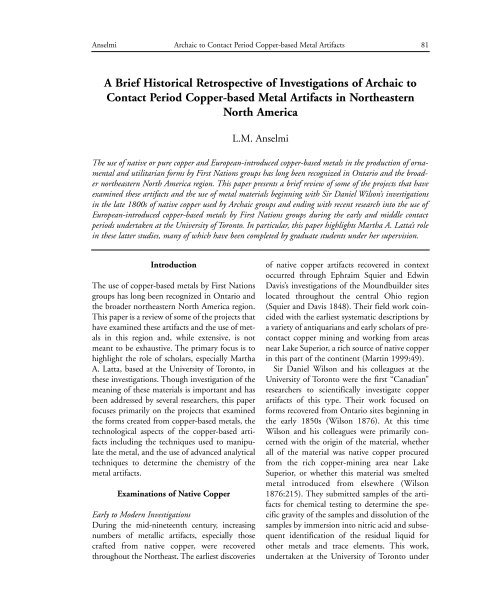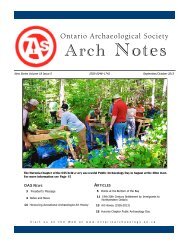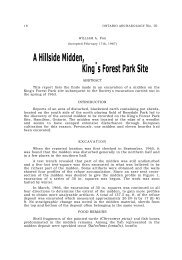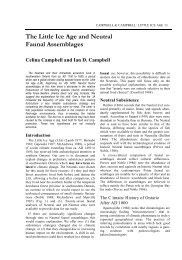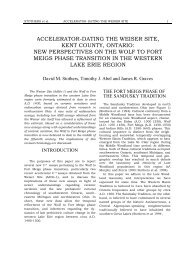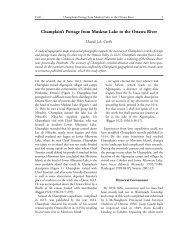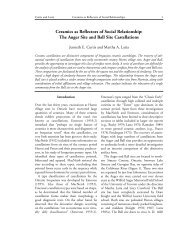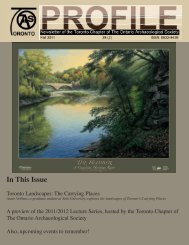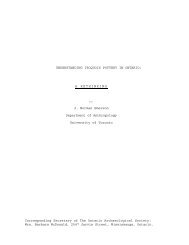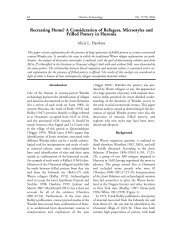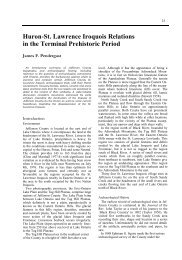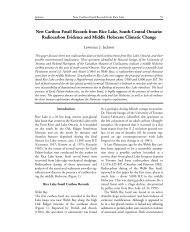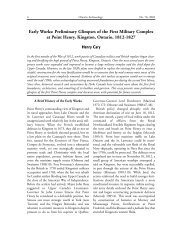oa 77-78 layout part 08 - Ontario Archaeological Society
oa 77-78 layout part 08 - Ontario Archaeological Society
oa 77-78 layout part 08 - Ontario Archaeological Society
Create successful ePaper yourself
Turn your PDF publications into a flip-book with our unique Google optimized e-Paper software.
Anselmi Archaic to Contact Period Copper-based Metal Artifacts 81A Brief Historical Retrospective of Investigations of Archaic toContact Period Copper-based Metal Artifacts in NortheasternNorth AmericaL.M. AnselmiThe use of native or pure copper and European-introduced copper-based metals in the production of ornamentaland utilitarian forms by First Nations groups has long been recognized in <strong>Ontario</strong> and the br<strong>oa</strong>dernortheastern North America region. This paper presents a brief review of some of the projects that haveexamined these artifacts and the use of metal materials beginning with Sir Daniel Wilson’s investigationsin the late 1800s of native copper used by Archaic groups and ending with recent research into the use ofEuropean-introduced copper-based metals by First Nations groups during the early and middle contactperiods undertaken at the University of Toronto. In <strong>part</strong>icular, this paper highlights Martha A. Latta’s rolein these latter studies, many of which have been completed by graduate students under her supervision.IntroductionThe use of copper-based metals by First Nationsgroups has long been recognized in <strong>Ontario</strong> andthe br<strong>oa</strong>der northeastern North America region.This paper is a review of some of the projects thathave examined these artifacts and the use of metalsin this region and, while extensive, is notmeant to be exhaustive. The primary focus is tohighlight the role of scholars, especially MarthaA. Latta, based at the University of Toronto, inthese investigations. Though investigation of themeaning of these materials is important and hasbeen addressed by several researchers, this paperfocuses primarily on the projects that examinedthe forms created from copper-based metals, thetechnological aspects of the copper-based artifactsincluding the techniques used to manipulatethe metal, and the use of advanced analyticaltechniques to determine the chemistry of themetal artifacts.Examinations of Native CopperEarly to Modern InvestigationsDuring the mid-nineteenth century, increasingnumbers of metallic artifacts, especially thosecrafted from native copper, were recoveredthroughout the Northeast. The earliest discoveriesof native copper artifacts recovered in contextoccurred through Ephraim Squier and EdwinDavis’s investigations of the Moundbuilder siteslocated throughout the central Ohio region(Squier and Davis 1848). Their field work coincidedwith the earliest systematic descriptions bya variety of antiquarians and early scholars of precontactcopper mining and working from areasnear Lake Superior, a rich source of native copperin this <strong>part</strong> of the continent (Martin 1999:49).Sir Daniel Wilson and his colleagues at theUniversity of Toronto were the first “Canadian”researchers to scientifically investigate copperartifacts of this type. Their work focused onforms recovered from <strong>Ontario</strong> sites beginning inthe early 1850s (Wilson 1876). At this timeWilson and his colleagues were primarily concernedwith the origin of the material, whetherall of the material was native copper procuredfrom the rich copper-mining area near LakeSuperior, or whether this material was smeltedmetal introduced from elsewhere (Wilson1876:215). They submitted samples of the artifactsfor chemical testing to determine the specificgravity of the samples and dissolution of thesamples by immersion into nitric acid and subsequentidentification of the residual liquid forother metals and trace elements. This work,undertaken at the University of Toronto under
82 <strong>Ontario</strong> Archaeology No. <strong>77</strong>/<strong>78</strong>, 2004the direction of Professor Henry Croft, led them toconclude that the sampled artifacts were fashionedfrom native or pure copper. Wilson also investigatedthe manufacturing techniques used for bothmining the copper and for fashioning artifactsfrom the metal (Martin 1999:54; Wilson1876:228, 237). Importantly, Wilson’s use of thecomparative method led him to evaluate the evidencerecovered in the Lake Superior regionagainst other areas of mining activity, in <strong>part</strong>icularthe mining districts of Wales. This led to his observationthat the basic technique used to work thematerial in North America – hammering – wasused by metalworkers in other <strong>part</strong>s of the world,suggesting that people confronting similar materialssolved manufacturing problems in similar ways(Martin 1999:54; Wilson 1876:228, 237).Through their investigations, Wilson and his colleaguesformally introduced the Lake Superiorregion as a probable source area of the native copperused by First Nations people throughout theNortheast, a model which has long been used withoutchallenge (see Martin 1999; also Levine 1996,1999 for arguments against this model).Many others have followed these early investigationswith their own examination and descriptionsof the native copper artifacts characteristic of theOld Copper Complex (and contemporary LateArchaic/Early Woodland period cultures), theAdena (and concurrent Early/Middle Woodlandperiod cultures), the Hopewell (and related Middleto Late Woodland cultures) and later Mississippiancultures (such as those artifacts recovered at theEtowah, Spiro and Moundville sites among otherlocations) (see for example Blitz 1986; Brown1989; Cree 1992; Esarey 1986; Fogel 1963;Fundaburk and Foreman 1957; G<strong>oa</strong>d and N<strong>oa</strong>kes1980; Goodman 1984; Greber and Ruhl 1989;Halsey 1996; Heckenberger et al. 1990; Jury 1965;Kenyon 1986; Larson 1959, 1989; Martin 1999;Popham and Emerson 1954; Ritzenthaler andQuimby 1962; Steinbring 1970, 1990, amongothers). The appr<strong>oa</strong>ches of these researchers varyextensively from simple description and counts ofrecovered artifacts (see for example Jury 1965) touse of advanced analytical techniques to addressquestions of source material and /or trade (seeG<strong>oa</strong>d and N<strong>oa</strong>kes 1980).Early Experimental Work on Native CopperThe earliest experimental work on the manufacturingtechniques used to construct native copperartifacts was by Frank Hamilton Cushing ofthe Bureau of American Ethnology in the 1890s(Cushing 1894; Martin 1999:113-114). Hiswork focused on copper objects recovered fromgroups in the contemporary Southwest (in <strong>part</strong>icularthe Zuñi) and from earlier Adena andHopewell sites. He experimented with differentmanufacturing techniques in an effort to determinethe process of manufacture used for theircreation and was the first to suggest that the techniquesemployed on metallic raw materials werebased on those used in the creation of otherobjects crafted from different raw materials suchas stone or shell (Cushing 1894:97). Cushingargued that almost all native communities usedheating techniques to produce hide or hornobjects and to straighten arrow-shafts and thatthis surely led to the application of heat on copper,which led to annealing of the material(Cushing 1894:98). Annealing of the copperenables the reversal of work-hardening effects ofinitial hammering of the object. After the applicationof heat, the copper returns to a more malleablestate. Cushing argued especially that thetechnological activities of hide-working andhammering copper into sheet have marked similarities,including the placement of material onstone anvils and the use of stone mauls to ‘spread’the hide and copper through a <strong>part</strong>icular hammeringpattern (Cushing 1894:100). Cushingexperimented with these techniques himself andfound it relatively easy to groove plates with boneor antler embossing tools and to remove theresulting figural designs by grinding the raisedlines present on the reverse surface of the piece(Cushing 1894:101-104). This process wouldleave raised edges on the removed pieces thatcould then be flattened after removal.Charles C. Willoughby’s early work echoedCushing’s work on metal objects fromMoundbuilder sites (see Martin 1999:116-119 fora general discussion; Greber and Ruhl 1989 forspecifics). Willoughby (1903:55) experimentedwith native copper from Lake Superior mining sitesand used traditional techniques of cold-working
Anselmi Archaic to Contact Period Copper-based Metal Artifacts 83and annealing in a successful attempt to duplicaterecovered Hopewell ear spool forms. He followeda simple manufacturing sequence, hammeringa nugget of native copper into sheet withwater-worn stones and performing a low-temperatureanneal of the pieces using a camp-fire. Hefinished the sheet he created by grinding it to auniform thickness between two flat stones, usingfine sand between them as an abrasive. He cutthe sheet into circular forms by using sharp flintsto outline the shape, breaking off the excessmaterial, and grinding the rough edges. He thencladded the experimental piece (i.e., worked thecopper sheet over a wooden form) he was trying torecreate and burnished the copper around the formusing an expedient pressing tool manufacturedfrom discarded bone. To finish the piece, he perforatedit using a flint ‘drill’ and polished the pieceusing a final grinding of fine sand followed by shiningwith wood ashes (Willoughby 1903:55).Additionally, a number of experimental studiesundertaken in the early 1980s, on native copper,showed that it would have been quite possible, iftime-consuming, for native craftsmen to manufactureobjects like tubular beads themselves (seeFranklin et al. 1981; Franklin 1982). UrsulaFranklin, a metallurgist formerly at theUniversity of Toronto, experimented with nativecopper in order to replicate copper objects recoveredfrom Thule, Copper Eskimo, Athabascanand Chipewyan contexts in the Canadian Arctic.She succeeded in duplicating the microstructuresobserved in the original pieces by following aworking-annealing-working-folding sequenceand also by hot working small fragments ofnative copper (Franklin 1982:50).Another experimental study, undertaken byJonathan Leader (then at the University ofFlorida), showed that metal artifacts were oftenbased on artifact forms crafted from other materialssuch as shell or wood and that the manufacturingtechniques employed were those initially usedon these other materials, an idea first put forwardby Cushing following his observations of Zuñimetalworkers (Cushing 1894; Leader 1988, 1991).This research focused on the retention of basictechniques over time and the adoption of newtechniques by examining metalworking techniquesused by different cultural groups in the Northeastfrom the Late Archaic (Old Copper Culture), toMiddle Woodland (Adena/Hopewell) andMississippian (Etowah and SoutheasternCeremonial complex) periods (Leader 1988).Appr<strong>oa</strong>ches to Analysis: Native CopperSophisticated analytical techniques, such as metallography,were also employed in the examination ofrecovered metal material during the very earliestphases of investigation of native copper artifacts.Curtis Wilson and Melville Sayre used this techniquein 1935 to compare native copper from theLake Superior region with copper recovered fromOhio mound sites and sites in Wisconsin (Wilsonand Sayre 1935). Metallographic study necessitatesremoval of a section of the study piece, then polishingand etching it to reveal its granular structure(Martin 1999:115; Vernon 1990:500; Wilson andSayre 1935:109). Those structures form specific patternsthat reflect the treatment of the metal, whetherit was annealed or cold worked, for example.Metallography, as well as advanced analyticaltechniques such as neutron activation analysis(NAA) and x-ray fluorescence spectroscopy(XRF), has also been applied to artifacts originallydescribed by Squier and Davis fromMoundbuilder sites in the Ohio River Valley andfrom Copper Inuit sites under the direction ofMichael Wayman and his colleagues at theSlowpoke Reactor Facility at the University ofAlberta (Wayman et al. 1992; Wayman et al.1985, respectively).Examination of European-introducedCopper-based MetalsDescriptions and the Construction of TypologiesEarly analytical work on artifacts made fromEuropean-introduced copper-based metals 1 frequentlytook the form of description and visualanalysis. This is <strong>part</strong>icularly true of WilliamBeauchamp’s (1903a, 1903b) work for the NewYork State Museum, which is a record of his personalobservations of metal implements andornaments recovered from precontact and postcontactsites in New York within the frameworkof br<strong>oa</strong>dly functional typologies that separated
84 <strong>Ontario</strong> Archaeology No. <strong>77</strong>/<strong>78</strong>, 2004ornamental forms (such as beads, pendants andbracelets) from utilitarian forms (such as projectilepoints and knives). Beauchamp discussed thegeneral importance of metal in native culture andincluded detailed drawings of the studiedobjects. Interesting is his description of severalexamples of copper and copper-alloy beaded“belts” on which roughly standard-size tubularbeads were apparently sewn in uniform rows,reminiscent of later wampum belt configurations(Beauchamp 1903b:Plate 25).In <strong>Ontario</strong>, David Boyle’s Annual <strong>Archaeological</strong>Reports were the primary venue for reporting earlyfinds of European-introduced copper-based metalartifacts (Boyle 1889, 1891, 1892, 1896). This primarilytook the form of detailed descriptions ofcopper-based metal artifacts as they were recoveredthrough intentional excavation or through farmingand construction activities throughout the regionduring the late 1880s and 1890s.The independent work of Beauchamp andBoyle foreshadowed W. J. Wintemberg’s analysisof objects recovered on Iroquoian sites in<strong>Ontario</strong> in the 1920s (1926) and Charles C.Willoughby’s examinations of objects recoveredfrom New England sites (Willoughby 1973),research which was undertaken in the 1930s.Like Beauchamp, Willoughby also describedlengths of copper and copper-alloy tubular beadsrecovered from sites of the early (ca. AD1480/1500-1614) and middle (ca. AD 1614-1690) contact periods (Willoughby 1973:237).The first researcher to tie the use of native copperand other metals to historical records wasT.A. Rickard (1934). His analysis highlighted thedifferences between native copper and Europeanintroducedcopper-based metals. Similarly, manyscholars have published descriptive essays ofarchaeological sites that include detailed descriptionsof the artifacts recovered. Examples includereports on grave sites in Rhode Island,Massachusetts, Nova Scotia, Long Island,<strong>Ontario</strong> (Brenner 1988; Chapin 1926, 1927;Dincauze 1974; Dunbar and Ruhl 1974; Fowler1973; Hadlock 1948; Harper 1957; Jeppson1964; Latham 1957; Noble 1971; Robbins1959, 1968; Sherman 1960) and from other sitesassociated with contact-period trading activities(Boisvert et al. 1994; Cox 1996). Site artifact catalogueshave also been produced for six of theearly contact Seneca sites (Sempowski andSaunders 2001; Wray et al. 1987; Wray et al.1991).William Fowler, working in the early 1970s,suggested from a visual examination of “certainexcavated evidence” that the Dutch importedtubular copper-based metal beads of uniformlength specifically for the fur trade (Fowler1973:30). Unfortunately, he revealed no detailsof this evidence nor do Dutch historical recordsof this period appear to support his claim.Reworking of European-introduced Copper-basedMetals as an IndustryIn the mid-1970s researchers shifted towards anacknowledgment of native choice and active adoptionof certain European trade goods during theearly and middle contact periods in the Northeast.Martha A. Latta, working with Wendat collectionsin <strong>Ontario</strong>, was the first researcher to recognizethat European trade kettles might have beenimportant as a raw material source rather than foruse in their European forms while James Bradley,working with Onondaga collections in New York,was the first to focus upon the use of copper andcopper-alloy materials as an industry equivalent tolithic or ceramic production (Bradley 1979, 1987a,b; Latta 1976: 229).Appr<strong>oa</strong>ches to Analysis: European-introducedCopper-based MetalsSimilar to its use in examining native copper artifacts,metallography has been applied in investigationsof European-introduced copper-basedmetals. Metallographic analysis makes it possibleto determine if the metal has been smelted,allowing the sorting of native and smelted coppersand alloys. This technique has been used byHelene Dunbar and Katherine Ruhl (1974) forthis purpose in their examination of seven copperartifacts recovered from the SusquehannockEngelbert site in New York. They determinedthat two of the artifacts had been formed fromnative copper, while the rest had been fashionedthrough the re-use of European-introducedsmelted copper-based metal.
Anselmi Archaic to Contact Period Copper-based Metal Artifacts 85James Bradley and S. Terry Childs noted thatmetallographic analysis provides a means forreconstructing the processes of manufacture aftercasting but recognized that, for postcontact artifactsrecovered in the Northeast, metallographicanalysis may also identify the last stages inEuropean processing of the original kettles orsheets rather than solely the Native metalworker’suse of annealing and cold working (Bradley andChilds 1987:55). They employed metallographicanalysis to ascertain the manufacturing techniquesused to create specific types of copperbasedmetal artifacts commonly known as spiralsand hoops found on several early Seneca,Onondaga and Susquehannock sites (Bradleyand Childs 1991). Their research highlighted thelikelihood that these spiral and hoop types weremanufactured by native artisans, based on threereasons (Bradley and Childs 1991:15). First, differentmetals were used for the same forms on thesame site, which would probably not be the caseif they were European-manufactured pieces.Second, the techniques used to manufacture thesepieces were well within the documented abilities ofprecontact Native metalworkers and there is noevidence for advanced techniques, such as solderingor joining, that were practiced in Europe duringthis time period. Third, the manufacture ofthese pieces varied but the pieces themselvesshowed similarity in shape and style, suggestingthat there was no one set of steps followed to makethese artifacts—i.e., no rigid chaîne opératoire—butrather individual or localized preferences (seeAnselmi 2004 for further discussion).Advanced Techniques: Identifying ChemicalCompositionAdvanced analytical techniques such as opticalemission spectrography (OES), electron microprobe(EMP), atomic absorption spectroscopy(AAS), proton-induced emission spectroscopy(PIXE), and especially neutron activation analysis(NAA), have been principally used to sortmaterials according to base metal, whether nativecopper, smelted copper or copper-alloy. This is of<strong>part</strong>icular importance as the presence of smelted,European-introduced metal is a diagnostic featureof early contact period sites.Optical emission spectrography (OES)involves the recording of emitted wavelengths oflight following the excitation of electrons, usuallyfrom an electrical source (flame, spark or arc;Leute 1987:141). Emitted wavelengths are specificto elemental composition of the sample testedand the more intense an emitted wavelength,the greater the amount of that element in thesample. Researchers at Revere Copper and Brass(New Bedford, Massachusetts) first used thistechnique to determine the chemistry of a copperbead discovered in a grave in Holyoke,Massachusetts, in the 1940s (General ResearchDe<strong>part</strong>ment 1942). Bradley and Childs (1987)used this method as well, though in combinationwith metallographic analysis to examine an artifactfrom the Palmer Site in Massachusetts in thelate 1980s. Their examination showed that theartifact was fashioned from smelted brass.Valerie Monahan (1990) tested 22 samples inthe early 1990s from a range of archaeologicalsites in the Maritimes using electron microprobe(EMP) in order to distinguish between nativeand smelted copper-based metal artifacts. InEMP, samples are subjected to a small electronbeam, causing the excitation of electrons at theintersecting surface location. As the electronsreturn to their original level they emit x-rays thatcan be measured and matched to elements presentin the sample (Leute 1987:148).Bradley and Childs (1991) used a combinationof metallographic techniques and atomic absorptionspectroscopy (AAS) to investigate the spiraland hoop ornaments recovered from Seneca,Onondaga and Susquehannock sites in theNortheast. AAS involves the measurement of visiblelight (Leute 1987:139). A sample tested inthis manner is aspirated into a hot flame. Thesample is exposed to light of a wavelength associatedwith the element of interest. If the elementis present, the light is absorbed, causing theupward movement of an electron for that element.The amount of light absorbed may berecorded and plotted to obtain the percentage ofthat element in the sample. The application ofAAS by Bradley and Childs revealed that all ofthe tested spirals and hoops were manufacturedfrom smelted copper and brass and further that
88 <strong>Ontario</strong> Archaeology No. <strong>77</strong>/<strong>78</strong>, 2004examined smelted copper-based metals usingboth simple and advanced analytical techniques.The first of these, in the mid-1990s, was my ownmaster’s thesis, which used neutron activationanalysis in combination with the scratch test andvisual examination to explore the copper-basedmetal collection recovered from the Auger site.Using the neutron activation analysis results from150 samples, I determined the minimum numberof kettles present in the sample group and suggestedpreference of material for artifact types. Iwas also able to suggest possible trading patternswithin and between interacting populations asreflected by the archaeological assemblages (seeabove, Anselmi 1995; Anselmi et al. 1997).Caroline Walker also undertook an analysis ofcopper-based metal artifacts for her master’sresearch in the mid-1990s (Walker et al. 1999).Her work applied both visual examination andneutron activation analysis to a number of Petunsite copper-based metal collections. She used theresults of the NAA to assist in the developmentof a new chronological seriation for the Petunsites. More recently, Paul Thibaudeau’s (2002)doctoral research on the Thomson Walker sitecollection focused on traces of use-wear. Hisresearch, which included an experimental component,found that several of the irregularlyshaped forms with evidence of working wereused for hide preparation.My own doctoral research sought to br<strong>oa</strong>denour understanding of the use of these metals byaboriginal peoples during the early and middlecontact periods through a comparative regionalappr<strong>oa</strong>ch (Anselmi 2004). I examined a numberof copper-based metal collections attributed tothe nations of the Wendat confederacy in<strong>Ontario</strong> and to the Seneca, Onondaga andMohawk nations of the Haudenosaunee confederacyin New York. I also examined contemporarycollections crafted by European metalworkersin the New World, such as those recovered atFrench Sainte Marie I and English Jamestownsites. Through this comparative appr<strong>oa</strong>ch and asmall experimental study, I was able to demonstratea predictable difference between the waysthat aboriginal individuals were working copperbasedmetals taken from introduced trade goodsand the ways that trained European metalworkerswere using similar materials. My post-doctoralresearch has included the examination of copper-basedmetal collections attributed to theSusquehannock. Analysis of the collected datacontinues but preliminary results suggest that theSusquehannock used copper-based metals in verydifferent ways than other Iroquoians.Without Martha A. Latta’s guidance andenthusiasm, none of these graduate student projectswould likely have been completed. Marti’scommitment to the investigation of copper-basedmetals, from their excavation to her own researchinto expedient tools as well as her support ofgraduate students, is one of the lasting legacies ofher long career in <strong>Ontario</strong> archaeology.ConclusionsInvestigations of the ways that native copper andEuropean-introduced copper-based metals havebeen used by aboriginal peoples have a long history.Recent investigations of the active ways thataboriginal people chose to recycle introducedcopper-based metals have been influenced byMartha A. Latta through both her personalresearch and her role as advisor to graduate students.Future work suggested by her own and herstudents’ research might focus on expanded usewearanalysis of copper-based metal artifacts aswell as implementation of an advanced analyticalprogram to test additional artifacts throughoutthe Northeast in order to ascertain their chemicalsignature. Once these data are collected, it maythen be possible to trace usage patterns across sitesas well as local and regional trading networks.Acknowledgments. This paper was originally presentedat a session in honour of Martha A. Latta atthe 2004 combined <strong>Ontario</strong> <strong>Archaeological</strong><strong>Society</strong>/Eastern States <strong>Archaeological</strong> Federationmeeting in Midland, <strong>Ontario</strong>. I wish to thank theorganizers of that session, Mima Kapches and PatReed, for their invitation to <strong>part</strong>icipate in the sessionand this volume. I would also like to thankMarti, the supervisor of both my master’s and doctoralresearch projects. I am ever grateful for hersupport and guidance.
Anselmi Archaic to Contact Period Copper-based Metal Artifacts 89Note1 The phrase “European-introduced copper-based metals” commonlyincludes both smelted copper and copper-alloys such asbrass, which were introduced into aboriginal cultures followingcontact with Europeans and may include materials manufacturedin European centers such as Nuremberg or altered byEuropeans in the New World at early settlement sites such asJamestown, Virginia (see discussion in Anselmi 2004).References CitedAnselmi, L.M.1995 Recycle and Rework: Huron Manipulation ofEuropean-Introduced Metal Trade Goods atthe Auger Site (BdGw-3), Simcoe County,<strong>Ontario</strong>. Unpublished MSc thesis, De<strong>part</strong>mentof Anthropology. University of Toronto,Toronto.2004 New Materials, Old Ideas: Native Use ofEuropean-Introduced Metals in theNortheast. Unpublished PhD dissertation,De<strong>part</strong>ment of Anthropology. University ofToronto, Toronto.Anselmi, L.M., M.A. Latta, and R.G.V. Hancock1997 Instrumental Neutron Activation Analysis ofCopper and Brass from the Auger Site(BdGw-3), Simcoe County, <strong>Ontario</strong>.Northeast Anthropology 53:47-59.Beauchamp, W.1903a Metallic Implements of the New York Indians.Bulletin 55. New York State Museum,Albany, New York.1903b Metallic Ornaments of New York Indians.Bulletin 73. New York State Museum, Albany,New York.Blitz, J.1986 The Mcrae Mound: A Middle WoodlandSite in Southeastern Mississippi. MississippiArchaeology 21(2):11-40.Boisvert, R., A. Spiess, and S. Fulton1994 Evidence of 17 th Century Fur Trade at theHormell Site, Freedom, New Hampshire.Paper presented at the Annual Spring Meetingof the Vermont <strong>Archaeological</strong> <strong>Society</strong>,Rutland, Vermont. Ms. on file, De<strong>part</strong>mentof Anthropology, Buffalo State College,Buffalo, New York.Boyle, D.1889 Annual <strong>Archaeological</strong> Report of <strong>Ontario</strong>1887-1888. Warwick Brothers, Toronto.1891 Annual <strong>Archaeological</strong> Report of <strong>Ontario</strong>1890-1891. Warwick Brothers, Toronto.1892 Annual <strong>Archaeological</strong> Report of <strong>Ontario</strong>1891. Warwick Brothers, Toronto.1896 Annual <strong>Archaeological</strong> Report of <strong>Ontario</strong>1894-1895. Warwick Brothers, Toronto.Bradley, J.1979 The Onondaga Iroquois 1500-1655: A Studyin Acculturative Change and Its Consequences.Unpublished PhD dissertation, De<strong>part</strong>ment ofAnthropology, Syracuse University, Syracuse,New York.1987a Evolution of the Onondaga Iroquois:Accommodating Change 1500-1655. SyracuseUniversity, Syracuse, New York.1987b Native Exchange and European Trade:Cross-Cultural Dynamics in the SixteenthCentury. Man in the Northeast 33:31-46.Bradley, J., and S.T. Childs1987 Analysis of a Copper Artifact from thePalmer Site, Westfield Massachusetts.Bulletin of the Massachusetts <strong>Archaeological</strong><strong>Society</strong> 48(2):53-57.1991 Basque Earrings and Panther’s Tails: The Formof Cross-Cultural Contact in SixteenthCentury Iroquoia. In Metals in <strong>Society</strong>: TheoryBeyond Analysis, edited by R.M. Ehrenreich,pp. 7-17. MASCA Research Papers in Scienceand Archaeology 8(2). University ofPennsylvania, Philadelphia.Brenner, E.1988 Sociopolitical Implications of MortuaryRitual Remains in 17 th Century NativeSouthern New England. In The Recovery ofMeaning: Historical Archaeology in theEastern United States, edited by M. Leoneand P. Potter Jr., pp. 147-181. SmithsonianInstitution Press, Washington D.C.Brown, J.1989 On Style Divisions of the SoutheasternCeremonial Complex: A RevisionistPerspective. In The Southeastern CeremonialComplex: Artifacts and Analysis, edited by P.Galloway, pp. 183-204. University ofNebraska, Lincoln.Chapin, H.1926 Unusual Indian Implements Found inRhode Island. Rhode Island Historical <strong>Society</strong>Collections 19(4):117-128.1927 Indian Graves: A Survey of the Indian Gravesthat have been Discovered in Rhode Island.Rhode Island Historical Collections 20(1):14-32.Cox, S.1996 Forest City Phase 2 Report. Ms. on file,Maine State Museum, Augusta, Maine.
90 <strong>Ontario</strong> Archaeology No. <strong>77</strong>/<strong>78</strong>, 2004Cree, B.1992 Hopewell Panpipes: A Recent Discovery.Midcontinental Journal of Archaeology 17(1):3-15.Cushing, F.H.1894 Primitive Copper Working: An ExperimentalStudy. American Anthropologist 7:93-117.Dincauze, D.1974 Introduction to Archaeology in the GreaterBoston Area. Archaeology of Eastern NorthAmerica 2(1):39-67.Drooker, P.1996 Madisonville Metal and Glass Artifacts:Implications for Western Fort AncientChronology and Interaction Networks.Midcontinental Journal of Archaeology21(2):145-190.1997 The View from Madisonville: ProtohistoricWestern Fort Ancient Interaction Patterns.Memoirs of the Museum of Anthropology31. University of Michigan, Ann Arbor.Dunbar, H., and K. Ruhl1974 Copper Artifacts from the Engelbert Site.Bulletin of the New York State ArcheologicalAssociation 61:1-10.Ehrhardt, K.2002 European Materials in Native AmericanContexts: Rethinking Technological Change.Unpublished PhD dissertation, De<strong>part</strong>mentof Anthropology, New York University, NewYork.2005 European Metals in Native Hands: RethinkingTechnological Change. University of AlabamaPress, Tuscaloosa.Ehrhardt, K., S. Nash, and C. Swann2000 Metal-forming Practices among theSeventeenth Century Illinois, 1640-1682.Materials Characterization 45:275-288.Esarey, D.1986 Red Ocher Mound Building and MarionPhase Association: A Fulton County, IllinoisPerspective. In Early Woodland Archaeology,edited by K.B. Farnsworth and T.E.Emerson, vol. 2, pp. 231-243. KampsvilleSeminars in Archaeology. Center forAmerican Archaeology, Kampsville Illinois.Fitzgerald, W.1988 Some Preliminary Thoughts on StylisticChanges to 16 th and 17 th Century CopperAlloy Kettles and Iron Axes. Kewa 88(1):3-19.Fitzgerald, W., and P. Ramsden1988 Copper Based Metal Testing as an Aid toUnderstanding Early European-AmerindianInteraction: Scratching the Surface. CanadianJournal of Archaeology 12:153-161.Fitzgerald, W., L. Turgeon, R.H. Whitehead, and J.Bradley1993 Late Sixteenth-Century Basque BandedCopper Kettles. Historical Archaeology27(1):44-57.Fogel, I.1963 The Dispersal of Copper Artifacts in the LateArchaic Period of Prehistoric North America.The Wisconsin Archeologist 44(3):129-180.Fowler, W.1973 Metal Cutouts of the Northeast. Bulletin of theMassachusetts <strong>Archaeological</strong> <strong>Society</strong> 34(3):24-29.Fox, W.A., R.G.V. Hancock, and L.A. Pavlish1995 Where East Met West: The New CopperCulture. Wisconsin Archaeologist 76(3-4):269-293.Franklin, U.M.1982 Folding: A Prehistoric Way of WorkingNative Copper in the North AmericanArctic. MASCA Journal 2(2):48-52.Franklin, U.M., E. Badone, R. Gotthardt, and B. Yorga1981 An Examination of Prehistoric CopperTechnology and Copper Sources in WesternArctic and Subarctic North America.<strong>Archaeological</strong> Survey of Canada, MercurySeries 101. National Museum of Man,Ottawa.Fundaburk, E.L., and M.D. Foreman (editors)1957 Sun Circles and Human Hands: TheSoutheastern Indians-Art and Industry.Privately published, Luverne, Alabama.General Research De<strong>part</strong>ment1942 Analysis of Copper Bead from Indian GraveHolyoke MA. Bulletin Massachusetts<strong>Archaeological</strong> <strong>Society</strong> 3(2):18.G<strong>oa</strong>d, S., and J. N<strong>oa</strong>kes1980 Prehistoric Copper Artifacts in the EasternUnited States. In Archeological Chemistry: ASourcebook on the Applications of Chemistry toArcheology, edited by Z. Goffer, pp. 335-346. Willey, New York.Goodman, C.G.1984 Copper Artifacts in Late Eastern WoodlandsPrehistory, edited by A.M. Cantwell. Centerfor American Archeology at NorthwesternUniversity, Evanston, Illinois.Greber, N., and K. Ruhl1989 The Hopewell Site: A Contemporary AnalysisBased on the Work of Charles C. Willoughby.Westview Press, Boulder, Colorado.
Anselmi Archaic to Contact Period Copper-based Metal Artifacts 91Hadlock, W.1948-1949Three Contact Burials from EasternMassachusetts. Bulletin of Massachusetts<strong>Archaeological</strong> <strong>Society</strong> 10:63-72.Halsey, J.R.1996 Without Forge or Crucible: AboriginalNative American Use of Metals and MetallicOres in the Eastern Woodlands. TheMichigan Archaeologist 42(1):1-58.Hancock, R.G.V.1976 Low Flux Multielement InstrumentalNeutron Activation Analysis in Archaeometry.Analytical Chemistry 48(11):1443-1445.Hancock, R.G.V., L.A. Pavlish, R.M. Farquhar, R.Salloum, W.A. Fox, and G.C. Wilson1991 Distinguishing European Trade Copper andNortheastern North American NativeCopper. Archaeometry 53(1):69-86.Hancock, R.G.V., W.A. Fox, T. Conway, and L.A. Pavlish1993 Chemical Analysis of <strong>Archaeological</strong> Copperand Brass from Northeastern <strong>Ontario</strong>.Journal of Radi<strong>oa</strong>nalytical and NuclearChemistry 168(2):307-315.Hancock, R.G.V., L.A. Pavlish, R.M. Farquhar, P.J.Julig, and W.A. Fox1994 Chemical Seriation of Northeastern NorthAmerican <strong>Archaeological</strong> Sites UsingCopper Artifacts. In Archaeometry of Pre-Columbian Sites and Artifacts, edited by D.A.Scott and P. Meyers, pp. 255-265. GettyConservation Institute, Los Angeles.Hancock, R.G.V., R.M. Farquhar, L.A. Pavlish, andW.D. Finlayson1995a Chemical Analysis of Copper and BrassSamples from Christian Island, GeorgianBay, <strong>Ontario</strong>. Journal of Radi<strong>oa</strong>nalytical andNuclear Chemistry 196(2):255-266.Hancock, R.G.V., L.A. Pavlish, R.M. Farquhar, andW.D. Finlayson1995b Analysis of Copper-Based Metals from<strong>Archaeological</strong> Sites at Crawford Lake,South-Central <strong>Ontario</strong>, Canada. In Tradeand Discovery: The Scientific Study ofArtefacts from Post-Medieval Europe andBeyond, edited by D.R. Hook and D.R.M.Gaimster, pp. 283-297. Occasional Paper109. British Museum, London.Hancock, R.G.V., L.A. Pavlish, W.A. Fox, and M.A. Latta1995c Chemical Analysis of Copper Alloy TradeMetal from a Post-Contact Huron Site in<strong>Ontario</strong>, Canada. Archaeometry 37(2):339-350.Hancock, R.G.V., L.A. Pavlish, R.M. Farquhar. andD. Knight1999 The Analysis of Brass Samples from the Balland Warminster Sites in Southern <strong>Ontario</strong>,Canada. In Metals in Antiquity, edited byS.M.M. Young, A.M. Pollard, P. Budd, andR.A. Ixer, pp. 341-347. British<strong>Archaeological</strong> Reports International Series792. Archaeopress, Oxford.Harper, J.R.1957 Two Seventeenth Century Micmac “CopperKettle” Burials. Anthropologica O.S. 4:11-36.Heckenberger, M., J. Petersen, and L. Basa1990 Early Woodland Period Ritual Use ofPersonal Adornment at the Boucher Site.Annals of Carnegie Museum 59(3):173-217.Jeppson, B.1964 A Study of Cordage and Rolled Copper Beads,Burial #6 Titicut Site. Bulletin Massachusetts<strong>Archaeological</strong> <strong>Society</strong> 25(2):37-38.Jury, W.1965 Copper Artifacts from Western <strong>Ontario</strong>.The Wisconsin Archaeologist 46(4):223-246.Kenyon, W.A.1986 Mounds of Sacred Earth: Burial Mounds of<strong>Ontario</strong>. Royal <strong>Ontario</strong> Museum ArchaeologyMonograph 9. Royal <strong>Ontario</strong> Museum,Toronto.Kingery, W.D.1993 Technological Systems and SomeImplications with Regard to Continuity andChange. In History from Things: Essays onMaterial Culture, edited by S. Lubar andW.D. Kingery, pp. 215-230. SmithsonianInstitution Press, Washington.Larson, L.J.1959 A Mississippian Headdress from Etowah,Georgia. American Antiquity 25(1):109-112.1989 The Etowah Site. In The SoutheasternCeremonial Complex: Artifacts and Analysis,edited by P. Galloway, pp. 133-141.University of Nebraska Press, Lincoln.Latham, R.1957 Seventeenth Century Graves At Montauk,Long Island. The Bulletin: New York State<strong>Archaeological</strong> Association 9:5-6.Latta, M.A.1976 The Iroquoian Cultures of Huronia: A Studyof Acculturation through Archaeology.Unpublished PhD dissertation, De<strong>part</strong>mentof Anthropology. University of Toronto,Toronto.
92 <strong>Ontario</strong> Archaeology No. <strong>77</strong>/<strong>78</strong>, 20041996 Use-Wear Studies on Brass and Copper Scrapfrom Protohistoric Canadian Sites. Acta, XIIICongresso Union of Prehistoric andProtohistoric Sicences, Forli, Italy. Ms. on file,De<strong>part</strong>ment of Anthropology, University ofToronto at Scarborough, Scarborough.2004 Engendering Metal-working in 17 th Century<strong>Ontario</strong> Iroquoian Sites. Paper presented atthe 37 th Annual Conference for the <strong>Society</strong> ofHistorical Archaeology, St. Louis, Missouri.Ms. on file, De<strong>part</strong>ment of Anthropology,University of Toronto at Scarborough,Scarborough.Latta, M.A., P. Thibaudeau, and L.M. Anselmi1998 Expediency and Curation: The Use andDistribution of “Scrap” Trade Metal by HuronNative Peoples in Sixteenth Century Southern<strong>Ontario</strong>. The Wisconsin Archeologist 79(1):175-184.Leader, J.M.1988 Technological Continuities and Specializationin Prehistoric Metalwork in the eastern UnitedStates. Unpublished PhD dissertation,De<strong>part</strong>ment of Anthropology, University ofFlorida, Miami.1991 The South Florida Metal Complex: APreliminary Discussion of the Effects of theIntroduction of an Elite Metal on a ContactPeriod Native American <strong>Society</strong>. In Metals in<strong>Society</strong>: Theory Beyond Analysis, edited by R.M.Ehrenreich, pp. 19-24. MASCA ResearchPapers in Science and Archaeology 8(2).University of Pennsylvania, Philadelphia.Leute, U.1987 Archaeometry: An Introduction to Physicalmethods in Archaeology and the History of Art.VCH Verlagsgesellschaft mbH, Weinheim,Germany.Levine, M.A.1996 Native Copper, Hunter-Gatherers, andNortheastern Prehistory. Unpublished PhDdissertation, De<strong>part</strong>ment of Anthropology,University of Massachusetts-Amherst, Amherst,Massachusetts.1999 Native Copper in the Northeast: AnOverview of Potential Sources Available toIndigenous Peoples. In The <strong>Archaeological</strong>Northeast, edited by M.A. Levine, K.Sassaman, and M. Nassaney, pp. 183-199.Bergin and Garvey, Westport, Connecticut.Martin, S.R.1999 Wonderful Power: The Story of AncientCopper Working in the Lake Superior Basin.Wayne State University Press, Detroit.Monahan, V.1990 Copper Technology in the Maritimes: anExamination of Indigenous Copper-workingin the Maritime Provinces during thePrehistoric and Protohistoric Periods.Unpublished Honours thesis, De<strong>part</strong>mentof Anthropology, Saint Mary’s University,Halifax, Nova Scotia.Moreau, J.F., and R.G.V. Hancock1993 Intra-site and Inter-site Differentiations ofCopper Based Artifacts from “Early Contact”Period (1600-1650) Sites from the EasternSubarctic of North America. In Proceeding fromthe 6 th Nordic Conference on the Application ofScientific Methods in Archaeology, Esbjerg 1993,edited by V. Mejdahl and P. Siemen, pp. 109-125. Arkaeologiske Rapporter 1. EsbjergMuseum, Esbjerg.1996 Chrono-Cultural Technique Based on theInstrumental Neutron Activation Analysis ofCopper-Based Artifacts from the “Contact”Period of Northeastern North America. In<strong>Archaeological</strong> Chemistry, edited by M.V.Orna, pp. 64-82. American Chemical<strong>Society</strong>, Washington D.C.Noble, W.C.1971 The Sopher Celt: An Indicator of EarlyProtohistoric Trade in Huronia. <strong>Ontario</strong>Archaeology 16:42-47.Popham, R., and J.N. Emerson1954 Manifestations of the Old Copper Industry in<strong>Ontario</strong>. Pennsylvania Archaeologist 24(1):3-19.Rickard, T.A.1934 The Use of Native Copper by the Indigenesof North America. Journal of the RoyalAnthropological Institute 44:265-287.Ritzenthaler, R.E., and G.I. Quimby1962 The Red Ocher Culture of the Upper GreatLakes and Adjacent Areas. Fieldiana:Anthropology 36(11):243-275.Robbins, M.1959 Some Indian Burials from SoutheasternMassachusetts Part 2—The WapanucketBurials. Bulletin of Massachusetts <strong>Archaeological</strong><strong>Society</strong> 20:61-67.1968 A Brass Kettle Recovery at Corn Hill, CapeCod. Bulletin of Massachusetts <strong>Archaeological</strong><strong>Society</strong> 29(3-4):62-68.Sempowski, M., and L. Saunders2001 Dutch Hollow and Factory Hollow: TheAdvent of Dutch Trade Among the Seneca. 3vols. Research Record 24. Rochester
Anselmi Archaic to Contact Period Copper-based Metal Artifacts 93Museum and Science Center, Rochester,New York.Sherman, C.1960 A Rare Copper Ax from the Powers ShellHeap. Bulletin of the Massachusetts<strong>Archaeological</strong> <strong>Society</strong> 21:17-19.Squier, E.G., and E.H. Davis1848 Ancient Monuments of the Mississippi Valley.Smithsonian Contributions to Knowledge 1.Washington, D.C.Steinbring, J.1970 Evidences of Old Copper in a NorthernTransitional Zone. In Ten Thousand Years:Archaeology in Manitoba, edited by W.Hlady, pp. 47-75. Manitoba <strong>Archaeological</strong><strong>Society</strong>, Winnipeg.1990 Early Copper Artifacts in WesternManitoba. Manitoba Journal of Archaeology1(1):25-63.Thibaudeau, P.2002 Use Wear Analysis on Cuprous Materials:Method and Theory. Unpublished PhD dissertation,De<strong>part</strong>ment of Anthropology.University of Toronto, Toronto.Vernon, W.1990 New Archaeometallurgical Perspectives onthe Old Copper Industry of North America.In <strong>Archaeological</strong> Geology of North America,edited by N.P. Lasca and J. Donahue, pp.499-512. Centennial Special Volume 4. TheGeological <strong>Society</strong> of America, Boulder,Colorado.Walker, C., R.G.V. Hancock, S. Aufreiter, M.A. Latta,and C. Garrad1999 Chronological Markers? Chemical Analysis ofCopper-based Trade Metal Artefacts fromPetun Sites in Southern <strong>Ontario</strong>, Canada. InMetals in Antiquity, edited by S.M.M. Young,A.M. Pollard, P. Budd, and R.A. Ixer, pp. 317-325. British <strong>Archaeological</strong> ReportsInternational Series 792. Archaeopress, Oxford.Wayman, M.L., R.R. Smith, C.G. Hickey, and M.J.M.Duke1985 The Analysis of Copper Artifacts of theCopper Inuit. Journal of <strong>Archaeological</strong> Science.12:367-375.Wayman, M.L., J.C.H. King, and P.T. Craddock1992 Aspects of Early North American Metallurgy.Occasional Paper 79. British Museum,London.Whitehead, R.H., L.A. Pavlish, R.M. Farquhar, andR.G.V. Hancock1998 Analysis of Copper-based Metals from ThreeMi’kmaq Sites in Nova Scotia. NorthAmerican Archaeologist 19(4):279-292.Willoughby, C.C.1903 Primitive Metal Working. AmericanAnthropologist 5:55-57.1973 Antiquities of the New England Indians withNotes on the Ancient Cultures of the AdjacentTerritory. AMS Press, New York. Originallypublished 1935, Peabody Museum ofAmerican Archaeology and Ethnology,Harvard University, Cambridge.Wilson, C., and M. Sayre1935 A Brief Metallographic Study of PrimitiveCopper Work. American Antiquity 2:109-112.Wilson, D.1876 Prehistoric Man: Researches in the Origin ofCivilisation in the Old and the New World.MacMillan and Co., London.Wintemberg, W.J.1926 Foreign Aboriginal Artifacts from Post-European Iroquoian Sites in <strong>Ontario</strong>.Transactions of the Royal <strong>Society</strong> of Canada20(2):37-61.Wray, C., M. Sempowski, and L. Saunders1991 Tram and Cameron: Two Early Contact EraSeneca Sites. 2 vols. Research Record 21.Rochester Museum and Science Center,Rochester, New York.Wray, C., M. Sempowski, L. Saunders, and G. C.Cervone1987 The Adams and Culbertson Sites. 2 vols.Research Record 19. Rochester Museum andScience Center, Rochester, New York.Zacharias, S.1983 Examination of 16 th -17 th Century Sheet Brassand Copper from Huronia. Ms. on file,De<strong>part</strong>ment of Anthropology, University ofToronto, Toronto.
94 <strong>Ontario</strong> Archaeology No. <strong>77</strong>/<strong>78</strong>, 2004En <strong>Ontario</strong> et dans toute la région nord-est de l’Amérique du Nord, on a depuis longtemps reconnuque les groupes des Premières Nations ont utilisé le cuivre natif, ou pur, et les métaux à base de cuivreintroduits par les Européens pour fabriquer des objets ornementaux et utilitaires. Cet articleprésente une brève revue de quelques projets qui ont examiné ce genre d’objets à la lumière de l’usagedes métaux. On débute par les enquêtes menées, dans les dernières années de 1800, par Sr DanielWilson concernant le cuivre natif utilisé par les Archaïques et on termine avec les recherches récentesentreprises par l’université de Toronto, recherches qui se rapportent à l’utilisation, par les groupes desPremières Nations, des métaux à base de cuivre introduits par les Européens durant les périodes decontact ancienne et moyenne. Cet article souligne en <strong>part</strong>iculier le rôle qu’a joué Martha A. Latta dansces dernières études, dont plusieurs ont été complétées par des étudiants gradués sous sa supervision.L.M. AnselmiAnthropology De<strong>part</strong>mentBuffalo State College1300 Elmwood Avenue,Buffalo, New York, USA 14222anselmlm@buffalostate.edu


